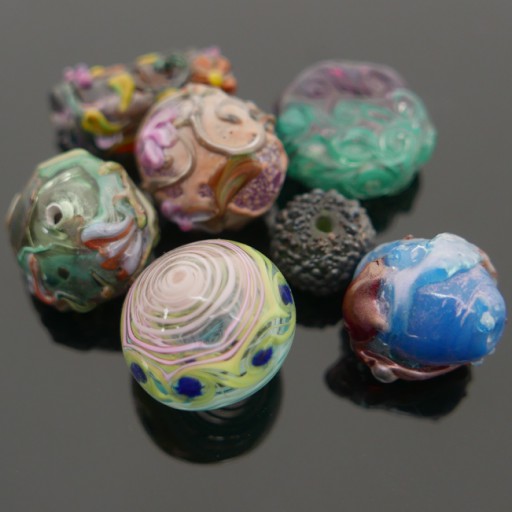These beads have been sitting around in dishes and bowls in the studio as “inspiration”. It's kind of interesting to see what ideas I pursued (the florals) and which ones I didn't (the pixie dust on opaque) and which ones represent some of my earliest ideas (the filigrana stripey, definitely, and also the purple and green filigrana tessellation.)

Assorted beads, many measuring approximately 1 inch. Made over a period of years; the striped filigrana is likely the oldest, and the florals the newest.
Now that they've been documented, I'd probably throw most of them away; really only the purple and green tessellation in the background is very interesting. —The purple, btw, was an artist made filigrana, whereas the two shades of green were commercial. But, just for the sake of completeness, let's break down what's going on here, roughly in chronological order of construction:
- (rainbow-ish) filigrana stripy with twist; (front & center)
- filigrana (incl artist made) tesselation (purple & green, upper right)
- german reactive frit, e.g. silver green (the small bead, middle right)
- pixie dust with texture & opaque colours (lower right)
- crisp floral (5 petal round flower technique) (brown cylinder, upper left)
- florals combined with shards (the green and tan florals along left/middle side)
All of these beads are hollow excepting the reactive glass one.
I have been interested in making beads with floral motifs from nearly the beginning, but the process was a rocky one because my stringer control was poor. Part of the problem is that hollow beads cool down faster than solid ones, so the tight focused flame and ‘working cold’ results (I believe, anyway) in more cracking: because there's not as much difference between the masses of the thin walls of the bead and thin stringer, keeping the bead warm enough tends to cause the stringer to over-melt, and working cold enough to keep the stringer crisp means the bead over cools and cracks.
With persistence, I did eventually master what I thought of as ‘crocus’ shaped flowers, which I usually put on vessels.
The stripey twist would eventually go on to become the lotus raked, made with two bands of colour, one filigrana and one solid, thereby echoing my construction methods, and substituting a simple rake for the twist. I like these beads a good deal, but the raking creates thin, weak spots in a hollow bead, which led to frustrating hole-pops in even mid-size focal beads. Therefore, when I do this technique, it's typically for designer (i.e. 12mm or smaller) sized beads.
Unless otherwise noted, text, image and objects depicted therein copyright 1996--present sylvus tarn.
Sylvus Tarn